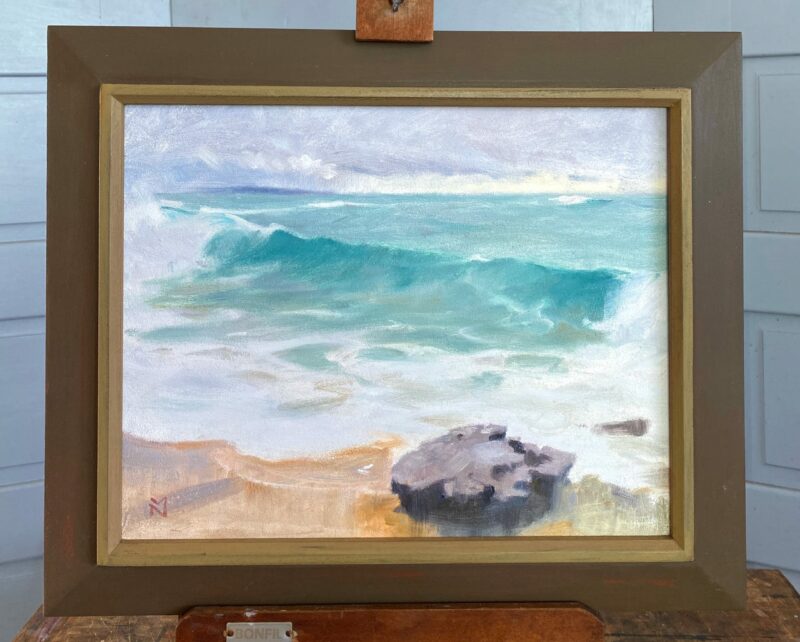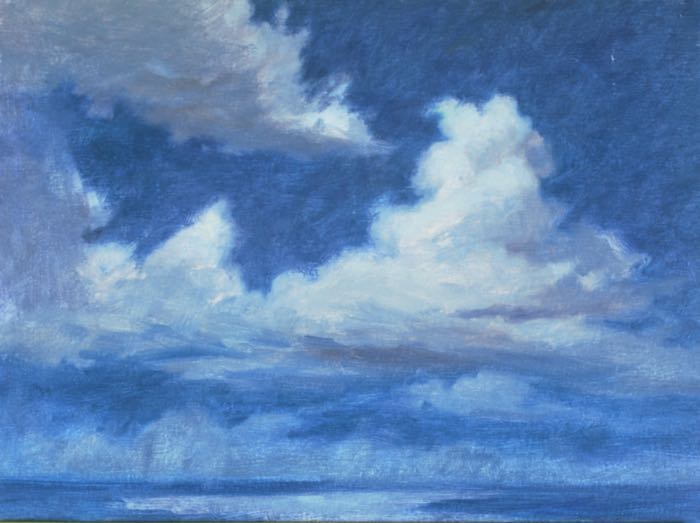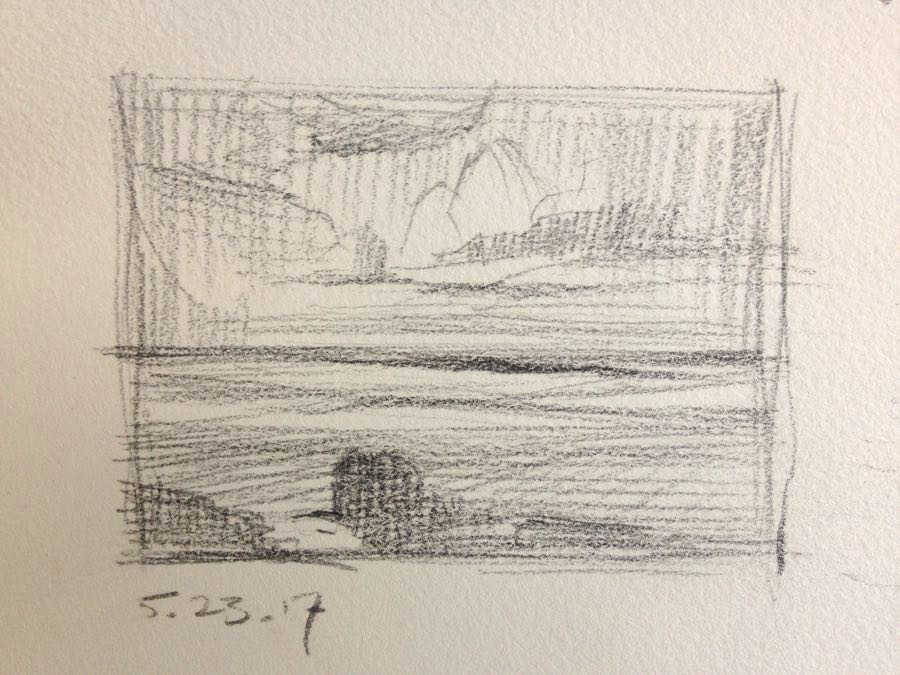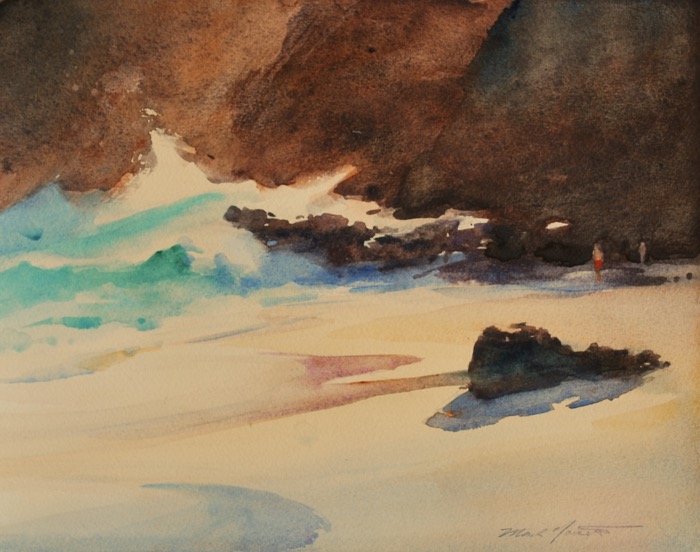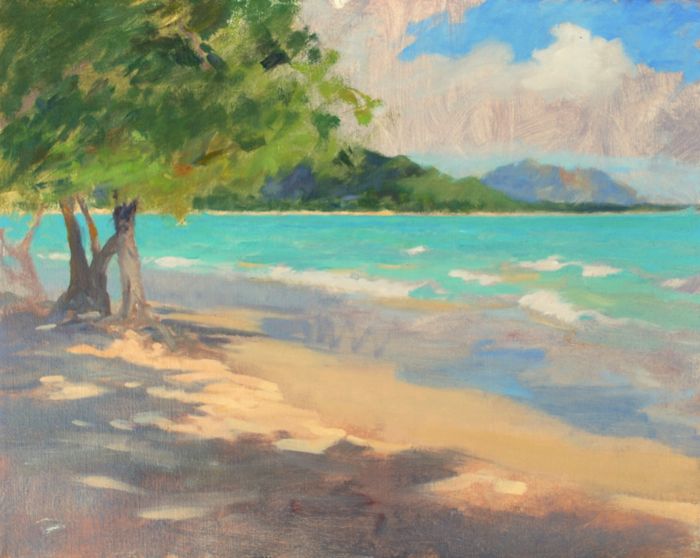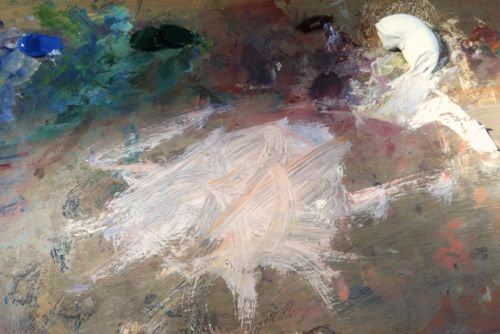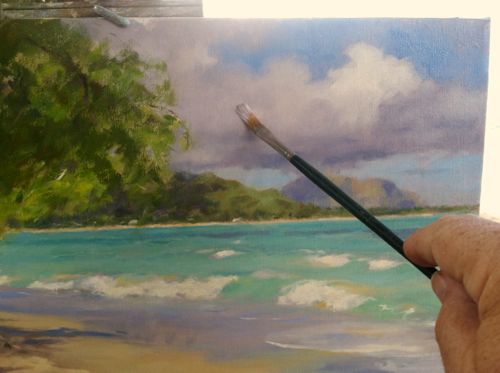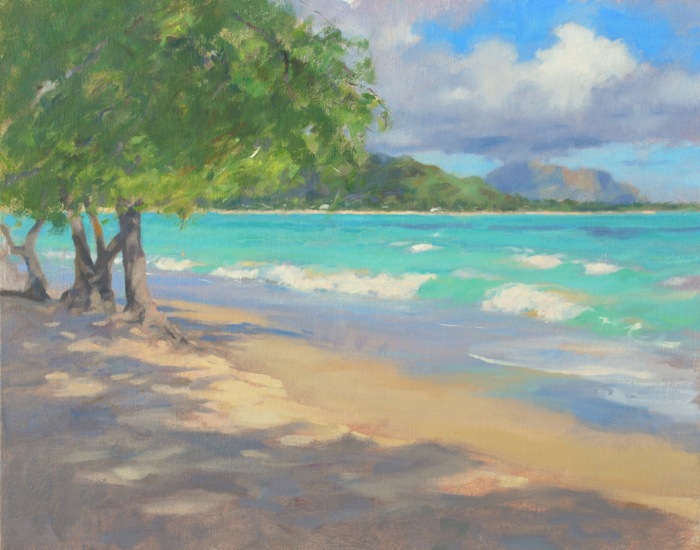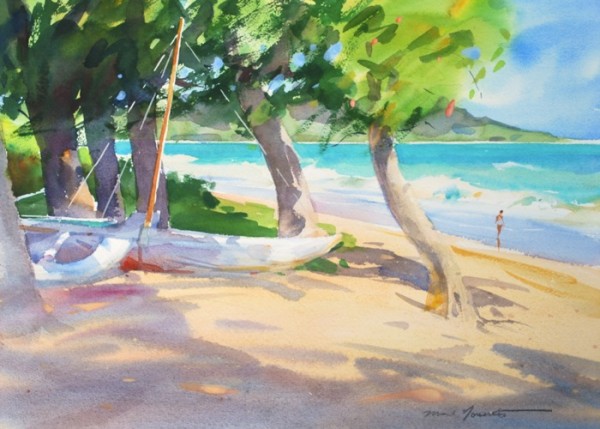This morning, Honolulu was greeted with overcast skies, so I immediately changed my painting plans to take advantage of the situation… because an overcast day is ideal for painting ocean studies.
“Ocean studies” are exercises. In painting and drawing, we gradually educate ourselves about the behavior and look of the ocean by repeated exposure. The more of this direct contact I have, the more fluent I’ll become, enabling me to paint with more confidence and authority.
With ocean work, “overcast” helps
Overcast is good because it’s on such days that I find the ocean easiest to paint. In Hawai’i, perhaps unlike other areas, finding shade to work in is critical. Oftentimes, the rocky coastlines I prefer lack shade. So it’s great news when we have some good cloud cover.
Some other points regarding overcast days:
-Almost all the values (shades of dark & light) will fall in the middle range. What this means is that the lightest whites of the breaking waves are slightly less than the pure white on my palette. The darks in rocks are slightly less dark than my darkest pigments. Therefore, our notes of color become closer to what can be reached with paint.
-Because sunlight is restricted, the effect of sunlight is diffused and doesn’t change as much during the painting session. This might give me more time to paint before the light changes.
My purpose in making studies
In anything I refer to as a “study”, my main intention is to learn by doing.
If a study looks good when finished, that’s terrific, and I want that to be the case. But that isn’t the entire target. Ocean studies are an ongoing seeking-out of design ideas, the “notes” of color (the actual look of the color in the right value), and the shapes and rhythms of the sea. By exposure to direct observation, brush in hand, a vocabulary can be built. That’s a skill I want to have internalized so that when struggling with a painting I’ll have a reliable sense of when I’m getting close to the look of nature….and when I’m not.
Ignore the spectacular
The ocean possesses numerous sensitive moods, and each has artistic value. The dramatic crashing wave-against-rock theme is not the only possibility, so it’s wise to become aware of others. The observation of the quiet-but-telling secondary actions of the sea is of great importance and is possibly the most difficult. Understanding that waves are visible, fluid manifestations of energy is a good framework for launching out on the work of painting the ocean, and if viewed that way, we may find interesting motives for paintings.
Getting practical
I’m generally hoping to be out early for ocean work. My setup is with a lightweight easel and color box that I’ve been favoring over the last few years. I carry the minimum of things needed, refined from a lot of practice, and pack my equipment the prior evening. When I arrive at the location, I don’t haul my equipment around looking for a spot. Rather, I look for my spot and then bring my equipment to it.
My palette for the ocean includes (Lead) White, Yellow Ochre, Cadmium Lemon, Indian Red, Permanent Crimson, and Viridian; for blues, Cerulean, Cobalt, and Ultramarine, and finally Ivory Black. For the painting to follow, I chose an 11 x14″ oil-primed wooden panel. This is large enough to allow some freedom of brushwork, but small enough to complete in a few hours. As the photos show, it’s mounted against a neutral gray backing, which allows a consistent middle gray around the margin of the study; this helps me judge things a bit better.
Composing
I always try to think through the composition of anything I put my brush to. That’s a discipline I need to practice. Art ultimately is dependent on taste…and so each step can at least be an effort in the direction of making better choices.
In this case, my interest was the action of the largest wave. Since the painting is so middle-value, I chose to include the rock (which is stationary and dark), and place it where I thought it would be most helpful to the overall design. This gave me something dark to measure the other values against. Also, the wet sand aspect introduced the only truly warm color notes (ochre), and added to the dark of the rock, really helps bring the study to life.
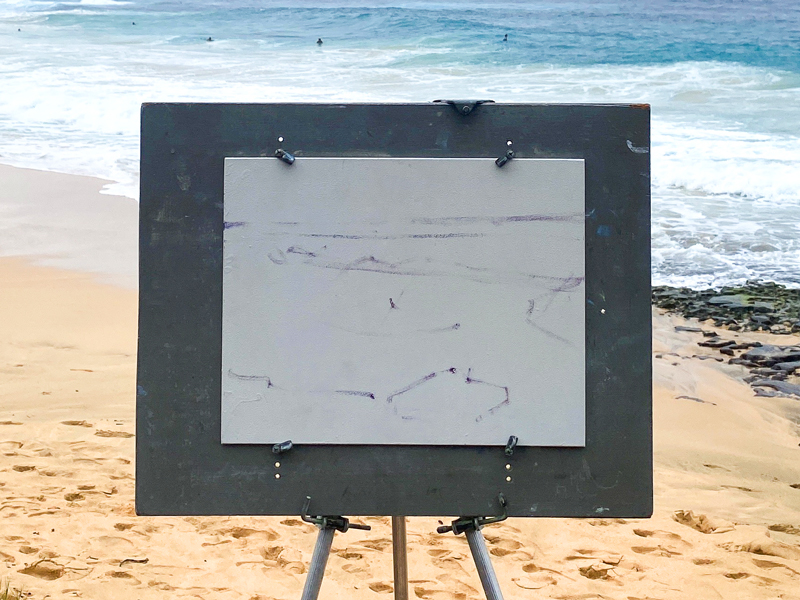
I always want the largest shapes (sky, sea, sand, white of the waves, etc) to contribute to an interesting pattern in and of themselves. In this case the division shown on the white panel, though done quickly, does reflect some concern for realizing that. Notice there’s a small “x” mark painted in the center of the canvas… it’s a help to arranging those big shapes. The lines are painted in after some planning with light charcoal lines, which were dusted off before the paint went on.
Painting general-to-specific
I always begin work from the most general towards the specific. This applies to shapes, values, and colors. So after the drawing in of the main shapes, my next objective is to seize the overall color-cast of this morning, which is a gray and cool effect. The best place is to begin with the sky, the furthest element from me and also the source of the light.
I mix a general value of blue gray, getting as close in color as I can to what I’m seeing. Using a large filbert brush I begin to lay-in the sky with a hearty amount of paint. I use individual brushloads placed side by side, something like a mosaic. My task here is to cover the white panel with a general value of each main color area. Once I get this, I will come back and refine the work. Virtually everything in my painting will be treated more than once, or more times. In the general-to-specific approach, it’s important to get the entire painting started (general), and suspend working on the specific (smaller elements and details) until that’s accomplished. Then, revisit each element, drawing it all together into a cohesive visual whole.
As I am doing this, I’m also watching the general motion of the sea, and considering how I might best capture the action of the waves, the purpose of the study.
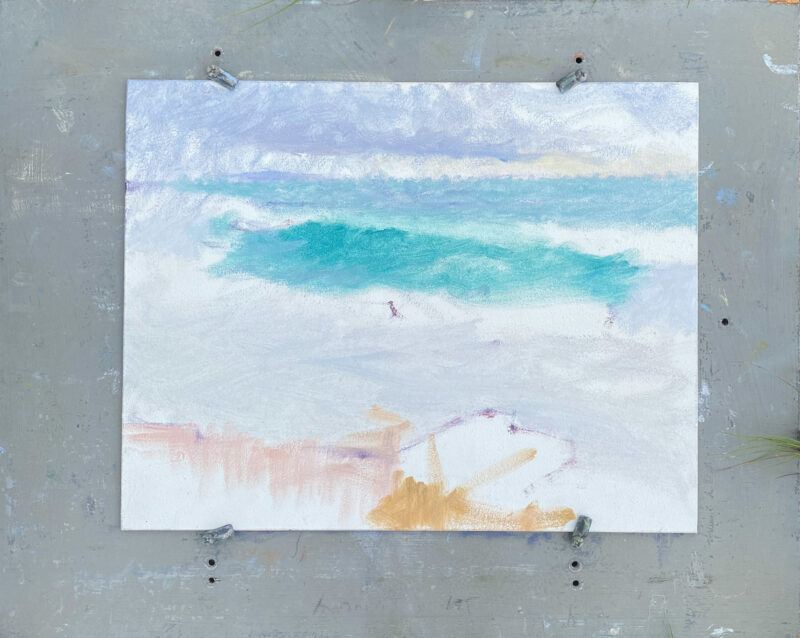
An important point to keep in mind, and the reason for starting with the sky, is that whatever is going on there is also happening in the ocean. Students hear me refer to the sky and the ocean as a married couple; one’s mood is affecting the other’s mood directly.
As I get the general effect of the sky in place, I begin to work that color down into the color of the water. Because we have overcast conditions, I can get the actual colors and values I see in the water without too much trouble.
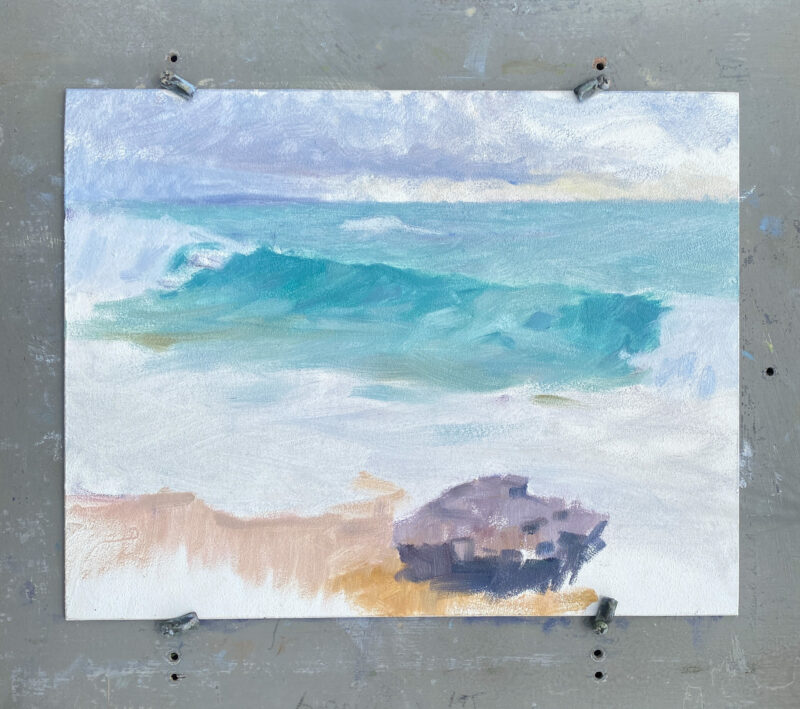
The large area of broken white water, generated by the breaking wave and shallow, sandy bottom, is a matter of getting just the right value of gray. I carefully mix what I need and, adjusting as I go, lay it in to the area. I’m using as much pigment as I can get on the brush, with only a touch of linseed oil. A well-loaded brush and individual brushstrokes placed one against the other is my procedure for building the painting.
My next move requires care….the general color of the rock, and especially it’s shadow side, needs to be dropped into place. because the dark shadow is the low end of my value scale.”How low”, compared to straight black, is important to judge correctly. I also look at the temperature of the dark (warm or cool?) and place it. Now, I can judge everything in the painting between the lightest and darkest notes of value…and adjust confidently now that these vital “bookends” are established.
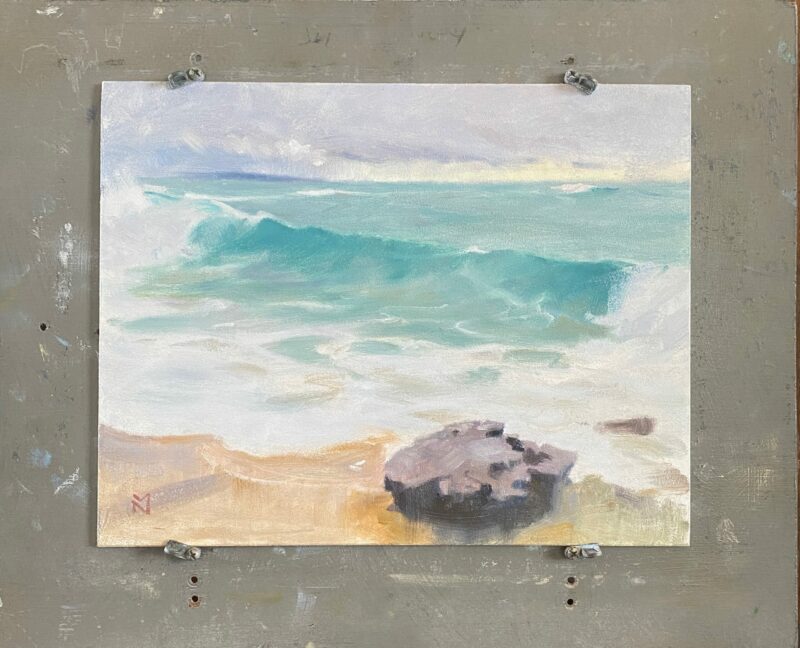
As the morning progresses, I have a nice amount of paint built up on the canvas. I’ve taken real care in getting the color of the face of the wave, the middle note, as close as I can to what I’m seeing. Having Viridian on my palette is important for this.
The sun’s made it’s presence known, having moved from behind the clouds and created some light/dark contrast in the green area of the wave. I now paint those darker notes with a reasonably large brush, thinking about the direction of the strokes. At this stage, how my brush work may add to the vitality of the action is paramount. During the initial lay in, it was less so. Because I have a good body of paint in place, these darker strokes ease into the existing paint beautifully.
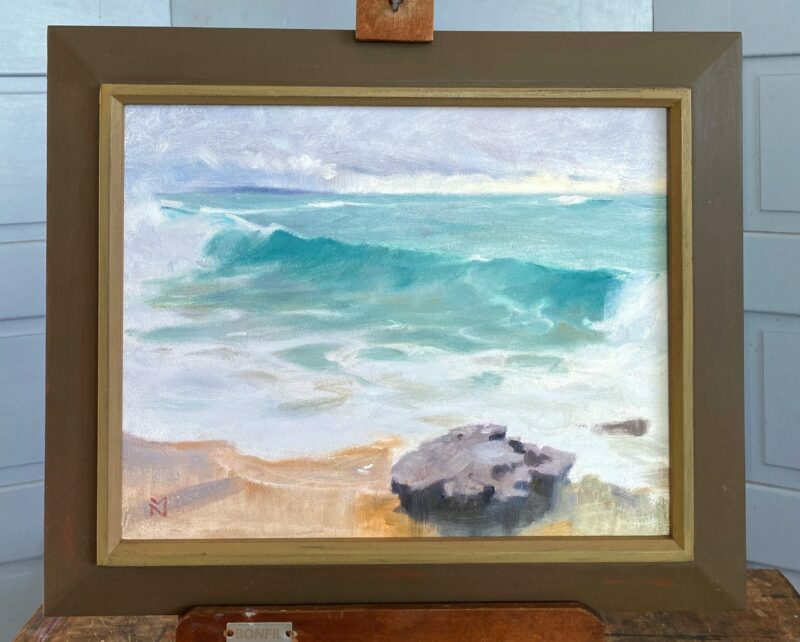
After about 90 minutes, the sunlight has managed to overcome the gray skies, and it’s unwise to continue. Doing so would introduce an entirely different concept, and one must avoid “chasing the light”.
I bring the painting back to the studio, and from memory and best judgement I make some adjustments. This stage, in actuality, is clarifying and simplifying. We don’t always make the best choices in the heat of battle, so checking back on the morning’s work after a break is always good.
Again, I’d like this to be a beautiful piece, but my real mission has been to objectively study the ocean, adding to my general knowledge of the sea. I add my monogram signature, and in 6 months the study will receive varnish for protection.
Please feel free to comment! Thanks!

